| Article ID | Journal | Published Year | Pages | File Type |
|---|---|---|---|---|
| 4573337 | Geoderma | 2014 | 9 Pages |
•Increasing soil salinity increased nitrous oxide (N2O) emissions.•Carbon dioxide (CO2) and N2 emissions decreased with increase in soil salinity.•Active amendments enhanced the conversion of N2O to N2 at all salinity levels.•Active amendments produced higher CO2 emissions compared to cured materials.•Greenwaste materials decreased N2O emissions compared to dairy manure amendments.
Soil salinity negatively affects the mineralization and nitrification processes of the N cycle and may also affect the production of nitrous oxide (N2O) and N2 to N2O–N ratios. Application of organic amendments such as manures and composts improves soil physical, chemical, and biological properties of salt-affected soils. However, because these materials both mineralize N and serve as substrates for denitrifiers, they may also increase N2O emissions. We studied the effect of organic amendments applied to saline soils on N2O emissions and on N2 to N2O–N ratios. Saline soils with electrical conductivity(ECe) measures of 2.8, 15.2, and 30.6 dS m− 1 were collected from Coachella Valley, California. Treatments included four organic amendments: active greenwaste compost (AGW), cured greenwaste compost (CGW), active dairy manure compost (ADM), and cured dairy manure compost (CDM). Treatments were incorporated at 50 Mg ha− 1 and incubated at 65% water-filled pore space (WFPS) for 60 days at 25 °C. Evolving cabon dioxide (CO2–C) and N2O–N were monitored along with soil ammonium (NH4+–N) and nitrate (NO3−–N) concentrations.The results showed that increasing soil salinity increased cumulative N2O–N losses but decreased CO2–C and N2 emissions and N2 to N2O–N ratios. Of all the amendments, the highest cumulative N2O–N and N2 emissions were produced from the ADM treatment at all three salinity levels. In general, incorporation of active compared to cured amendments increased N2 to N2O–N ratios at all three salinity levels suggesting that applying active organic materials could be useful in mitigation of N2O emissions from salt-affected soils under remediation.
